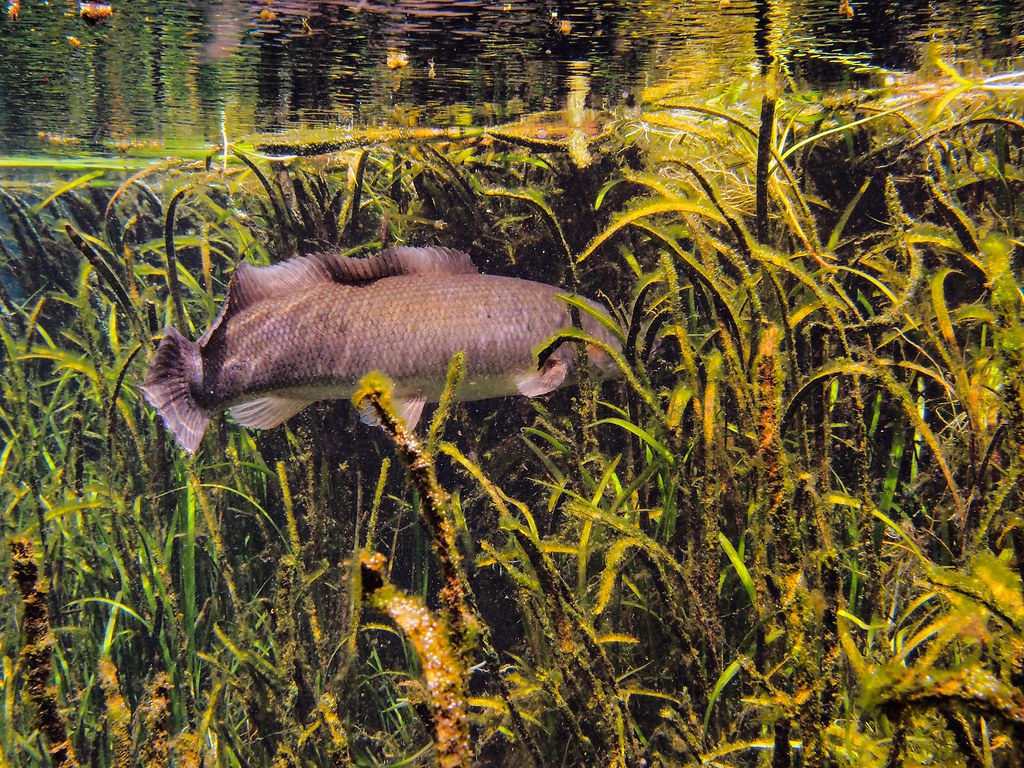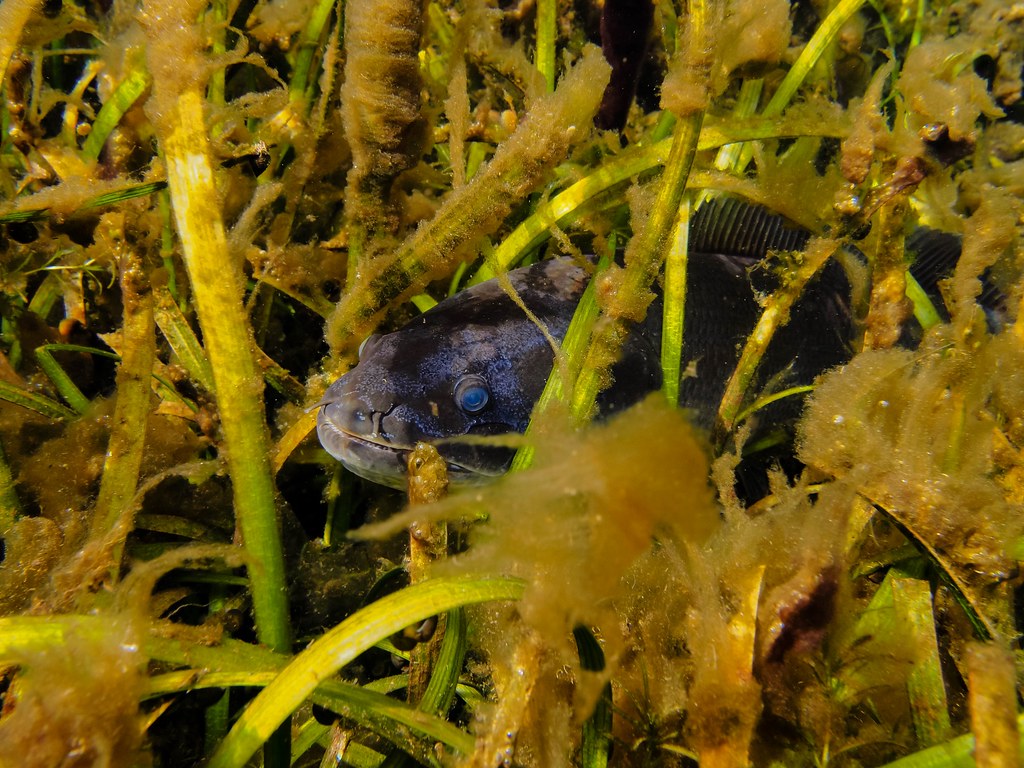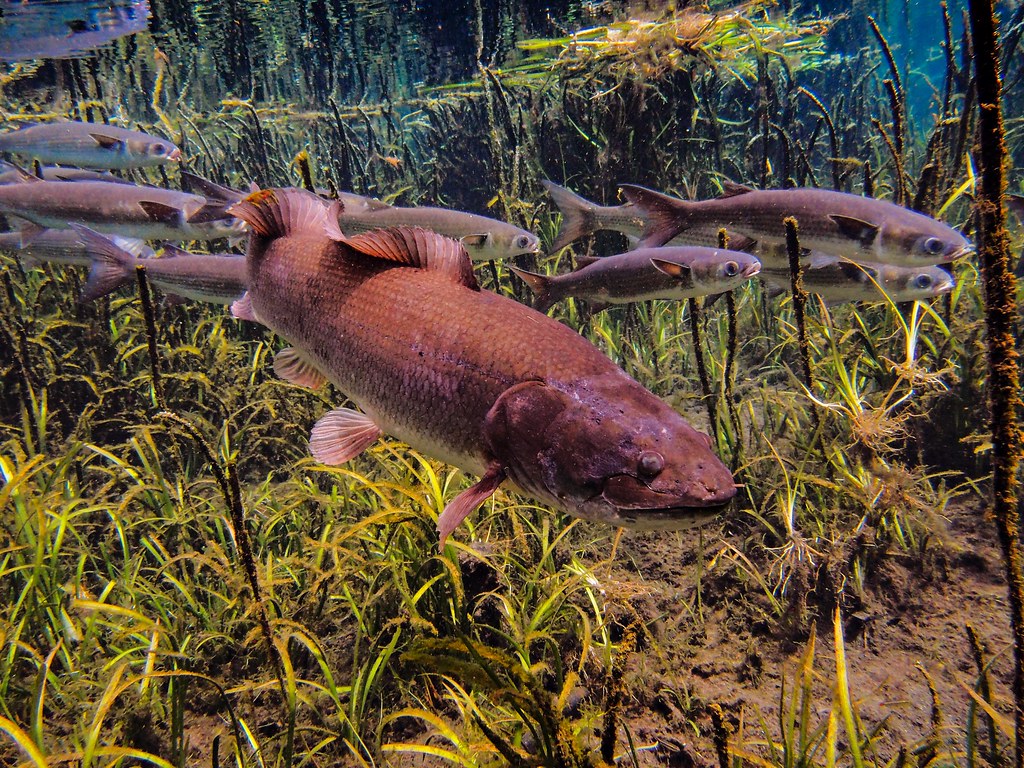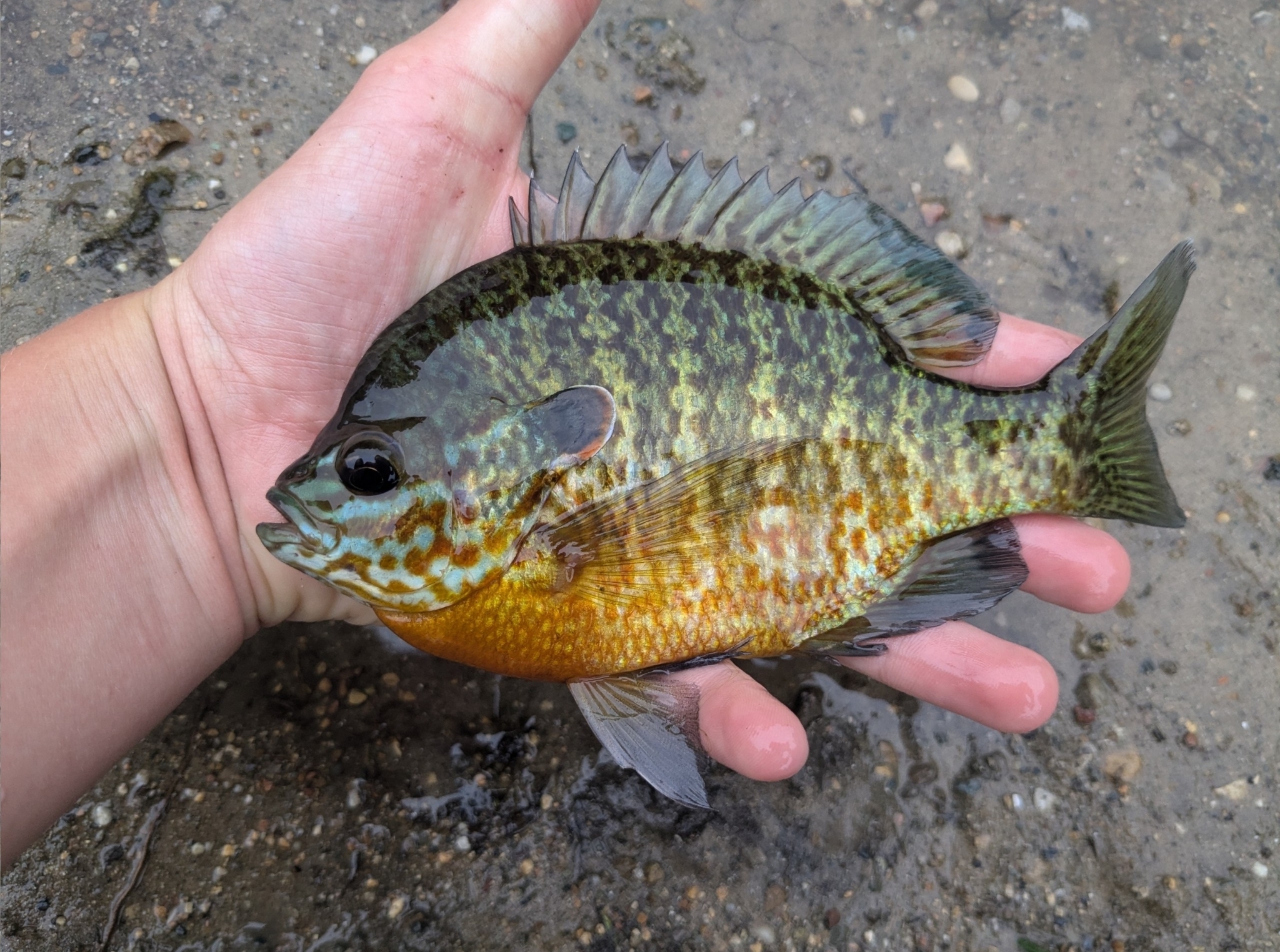Bowfin Basics: An Ancient Fish You Might Be Overlooking
In the murky waters of North America’s lakes, rivers, and swamps swims a living fossil that has remained largely unchanged for over 100 million years. The bowfin (Amia calva), sometimes called dogfish, mudfish, or grindle, represents the sole surviving species of the order Amiiformes.
Despite its remarkable evolutionary resilience and fascinating biological adaptations, the bowfin often lurks in obscurity. They are overshadowed by more commercially valuable game fish. This prehistoric survivor deserves greater recognition not just for its ancient lineage, but also for its ecological importance and the unique window it provides into our aquatic evolutionary past.
As anglers and conservationists alike develop greater appreciation for native species, the bowfin stands ready for its moment in the spotlight—an overlooked treasure hiding in plain sight.
The Living Fossil: Bowfin’s Evolutionary Significance

The bowfin holds a special place in evolutionary biology as one of the few remaining representatives of primitive bony fishes that flourished during the Jurassic period. While dinosaurs walked the Earth, the bowfin’s ancestors were already well-established in freshwater ecosystems. They have also maintained their basic body plan remarkably constant for approximately 150 million years. This extraordinary evolutionary stability has earned bowfins the classification of “living fossil.” It is a term reserved for organisms that have experienced little morphological change over vast periods of geological time.
Scientists value the bowfin as a crucial link between more primitive fish like gars and more advanced teleost fishes that dominate today’s waters. Their study provides invaluable insights into vertebrate evolution, particularly the development of air-breathing capabilities and transitional skeletal structures that characterize the progression from ancient to modern fish forms.
Unmistakable Appearance: Identifying the Bowfin

The bowfin possesses a distinctive appearance that makes identification relatively straightforward once you know what to look for. Their cylindrical, elongated bodies typically reach 18-24 inches in length, though specimens exceeding 30 inches have been documented.
Perhaps their most recognizable feature is the long, undulating dorsal fin that runs along much of their back, giving them their “bowfin” name. Their heads are armored with bony plates, featuring a wide mouth filled with sharp, conical teeth designed for seizing prey. You can distinguish males by the pronounced ocellus or “eyespot” at the base of their tail—a black spot ringed with orange or yellow that likely plays a role in spawning behaviors. Their coloration ranges from olive-green to brown with mottled patterns providing excellent camouflage in their preferred vegetated habitats. Meanwhile, their undersides display lighter hues of cream or yellow.
Remarkable Respiratory Adaptations

Perhaps the most fascinating aspect of bowfin biology is their advanced respiratory system that allows them to thrive in oxygen-depleted waters where most fish would suffocate. Bowfins possess a modified swim bladder that functions as a primitive lung. It enables them to gulp air at the water’s surface when dissolved oxygen levels drop. This adaptation, known as aerial respiration, represents an important evolutionary stepping stone between fully aquatic fish and air-breathing vertebrates.
During hot summer months when stagnant backwaters become nearly anoxic, you can observe bowfins regularly surfacing to take air breaths, their dorsal fins often breaking the water’s surface. This respiratory flexibility explains their remarkable resilience in habitats that experience seasonal oxygen fluctuations. It also allows them to survive in areas where other predatory fish cannot, reducing competition for food resources.
Habitat Preferences and Distribution

Bowfins inhabit a wide range of freshwater environments across eastern North America, from the Great Lakes and Mississippi River basin to the coastal plains along the Gulf of Mexico and Atlantic seaboard. They show a strong preference for slow-moving or stagnant waters with abundant vegetation, making swamps, oxbow lakes, backwater sloughs, and vegetated coves of reservoirs their primary domains.
Unlike many fish species that require specific water quality parameters, bowfins demonstrate impressive tolerance for poor conditions, including high temperatures, low oxygen, and even mild pollution. Their geographic distribution has remained relatively stable in recent centuries, though habitat fragmentation from dam construction has isolated some populations.
Conservation efforts to preserve wetland habitats indirectly benefit bowfin populations. However, they rarely feature as target species in such initiatives despite their ecological importance.
Predatory Behavior and Feeding Habits

Bowfins are opportunistic predators with feeding habits that reflect both their primitive origins and their ecological role as mid-to-top level predators in freshwater ecosystems. Their diet consists primarily of other fish, crayfish, frogs, and various aquatic invertebrates. They hunt using a combination of ambush techniques and active pursuit.
During daylight hours, bowfins often lurk among vegetation, their mottled coloration providing excellent camouflage as they wait for prey to venture too close. As darkness falls, they become more active hunters, using their acute senses to track prey through murky waters. Their powerful jaws and sharp teeth enable them to capture and consume relatively large prey, considering their body size. This predatory efficiency makes bowfins important biological controls on populations of smaller fish and crustaceans. They also help maintain balanced aquatic communities in the waters they inhabit.
Reproductive Strategy and Parental Care

The reproductive biology of bowfins includes several fascinating behaviors that distinguish them from many other fish species, particularly their dedicated parental care. Spawning typically occurs in spring when water temperatures reach approximately 65°F, with males establishing and vigorously defending territories in shallow, vegetated areas. After courtship, females deposit thousands of adhesive eggs onto submerged vegetation or excavated nests, which the males then fertilize. What makes bowfins remarkable is that after spawning, the females depart while males remain to guard both eggs. The males also guard newly hatched young for several weeks.
You can observe the protective male circling his brood, creating water currents that provide oxygen to the developing eggs and aggressively chasing away potential predators. This level of paternal care is relatively uncommon among fish species. This also represents an advanced reproductive strategy that helps ensure higher survival rates for offspring.
Misconceptions and Poor Reputation

Despite their biological significance, bowfins have historically suffered from an undeserved negative reputation among anglers and the general public. People often malign them as “trash fish” or wrongly accuse them of depleting game fish populations through predation. This reputation stems partly from their appearance—with primitive features that some find unappealing—and partly from misinformation about their ecological impact.
Some anglers have practiced the harmful tradition of killing captured bowfins and discarding them on shore, believing they were performing a service for game fish populations. Modern fisheries research has thoroughly debunked these misconceptions, demonstrating that bowfins are native predators that have coexisted with other fish species for millions of years. Bowfins also play important roles in maintaining balanced aquatic ecosystems. Conservation organizations conducted educational efforts that began to slowly shift public perception toward a more accurate understanding of these remarkable ancient fish.
Bowfins as Sportfish: The Fighting Quality

Those who have hooked a bowfin often describe an unforgettable battle that rivals or exceeds many more popular game fish. When struck, bowfins typically respond with explosive initial runs followed by dogged, powerful resistance that can test both tackle and angler. Their strength comes from a muscular body designed for quick bursts of speed when ambushing prey, coupled with remarkable stamina enabled by their air-breathing capability.
Unlike some fish that tire quickly, bowfins can sustain high-energy fights for extended periods, often punctuated by acrobatic jumps and head-shaking displays reminiscent of largemouth bass but with greater power. Experienced bowfin anglers recommend medium-heavy tackle with abrasion-resistant line to handle their sharp teeth and tendency to seek cover in vegetation or submerged structures.
The growing catch-and-release ethic among sport anglers has contributed to an increasing appreciation for bowfins as worthy sport fish, with some anglers specifically targeting them for their challenging fights and primitive mystique.
Ecological Importance in Aquatic Ecosystems

Bowfins serve crucial ecological functions that contribute to the health and balance of the freshwater ecosystems they inhabit. As mid-to-top level predators, they help regulate populations of smaller fish and invertebrates, preventing any single species from dominating and maintaining biodiversity throughout the food web. Their ability to thrive in oxygen-depleted environments allows them to occupy ecological niches that would otherwise remain vacant during seasonal periods of low oxygen, particularly in summer months when heat reduces dissolved oxygen levels in shallow waters.
Bowfins also serve as prey for larger predators including alligators, large wading birds, and even larger fish like alligator gar, completing important energy transfer cycles within wetland ecosystems. Additionally, researchers have begun exploring bowfins as potential bioindicators for ecosystem health, as their presence and condition can reflect broader environmental factors affecting aquatic habitats.
Culinary Considerations: Bowfin on the Table

Contrary to persistent myths about their palatability, properly prepared bowfin can provide a satisfactory culinary experience, though with some important considerations. The flesh is firm and white when fresh, but requires immediate cleaning and icing to prevent deterioration, as the high oil content that gives them fighting stamina can quickly turn rancid in warm conditions.
Traditional preparation methods in Louisiana and other southern states include smoking the meat or incorporating it into spicy dishes like courtbouillon, where bold seasonings complement its distinctive flavor profile. People consider the fish’s roe, known as “Cajun caviar” in some regions, a delicacy when properly processed, and occasionally market it as an affordable alternative to traditional sturgeon caviar.
While never likely to rival popular food fish like walleye or trout in mainstream preference, bowfin represents a sustainable protein source with cultural significance in regional cuisines, particularly in Cajun and some Native American culinary traditions.
Conservation Status and Threats
Bowfins currently maintain stable populations throughout most of their range, with the International Union for Conservation of Nature (IUCN) listing them as a species of “Least Concern.” This relatively secure status stems from their remarkable adaptability, tolerance for poor water conditions, and lack of significant commercial exploitation. However, they do face localized threats that merit monitoring and conservation attention.
Wetland drainage for agricultural and urban development continues to eliminate prime bowfin habitat in many regions, while water pollution from industrial sources can compromise even their impressive environmental tolerance.
Climate change presents an emerging concern, as alterations to precipitation patterns and water temperatures could potentially disrupt spawning cycles or change the composition of prey communities upon which bowfins depend.
Conservation strategies that preserve backwater habitats and maintain connectivity between waterways benefit bowfins alongside more high-profile species, making them inadvertent beneficiaries of broader aquatic conservation efforts.
Scientific Research Value
The bowfin’s status as a living fossil makes it an invaluable subject for various fields of scientific research that extend beyond basic ichthyology.
Evolutionary biologists study bowfins to understand the development of air-breathing organs in vertebrates, as their gas bladder represents an important transitional structure between fish gills and tetrapod lungs. Genomic research on bowfins has yielded insights into the molecular evolution of vertebrates, with their genome serving as an important reference point between more primitive fishes like lamprey and modern teleosts.
Physiologists have investigated the bowfin’s remarkable ability to tolerate low oxygen environments, research that may have applications for understanding hypoxic stress in other organisms including humans. Their unique reproductive behaviors also attract attention from behavioral ecologists studying the evolution of parental care strategies. This scientific value alone justifies conservation efforts directed toward bowfins and their habitats, as they represent irreplaceable windows into evolutionary processes that shaped all vertebrate life.
Engaging with Bowfins: Fishing Tips and Techniques
For anglers interested in deliberately targeting bowfins, several effective approaches can increase success while promoting ethical fishing practices.
Live bait presentations, particularly with minnows, crayfish, or large night crawlers, tend to produce the most consistent results when fished near the bottom in vegetated areas. Artificial lures including spinnerbaits, diving crankbaits, and soft plastic creature baits can also entice strikes, especially when retrieved with occasional pauses that mimic injured prey.
Since bowfins often inhabit areas with submerged vegetation and other potential snags, weedless rigging methods prove particularly valuable for reducing lost tackle. When handling caught bowfins, anglers should exercise caution around their powerful jaws and sharp teeth; specialized fish grips or landing nets help facilitate safe hook removal.
Catch-and-release practices benefit bowfin populations, with proper handling techniques including minimizing air exposure, supporting the fish’s body horizontally, and allowing recovery before release.
Photographing these prehistoric creatures can provide lasting mementos of encounters with living fossils without permanently removing them from their ecological roles.
Conclusion
The bowfin stands as a remarkable example of evolutionary persistence—a window into Earth’s distant past swimming through modern waters. As we develop a greater appreciation for native species and their ecological roles, these ancient fish deserve recognition not just as curiosities but as important components of healthy aquatic ecosystems. Their unique adaptations, particularly their air-breathing capability and parental care behaviors, represent fascinating biological innovations that have stood the test of evolutionary time.
For anglers seeking new challenges, conservationists concerned with preserving biodiversity, or anyone fascinated by living connections to prehistoric times, the bowfin offers abundant reasons for interest and respect. Next time you’re near the slow-moving waters of eastern North America, remember that just beneath the surface might swim a creature whose lineage predates most dinosaurs—a resilient survivor whose story encompasses millions of years of Earth’s history.













Post Comment